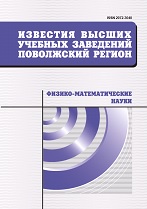|
This article is cited in 2 scientific papers (total in 2 papers)
Physics
Microstructural features of the composite material “aluminum - multi-wall carbon nanotubes” after spark plasma sintering
N. A. Bunakova, D. V. Kozlova, V. N. Golovanova, M. S. Efimova, I. S. Belobrova, A. A. Adamovicha, D. E. Sugakb
a Ulyanovsk State University, Ulyanovsk
b LLC «Promyshlennaya ekologiya», Ulyanovsk
Abstract:
Background. Rapid progress in science and techniques requires unique performance characteristics of the structural and functional materials. Metal matrix composites strengthened by dispersed particles and fibers replacing conventional materials are responsible for the breakthrough advances in this field. Composites with multi-walled carbon nanotubes (MWCNTs) added as a hardening phase can launch development of materials demonstrating unique combination of physical and chemical properties. On the other hand, manufacturing of such composites requires experimental studies to elaborate technological regimes enabling development of materials with the required properties and to study relation between the initial state of components and technological aspects of their processing to the performance characteristics obtained. In this work, microstructural changes in the aluminum matrix composite by MWCNTs adding in the process of spark-plasma sintering (IPA) have been studied. Materials and methods. The aluminum powder PAD-6* (Production Ltd. "VALCOM-PM") with 99.9 % purity and pristine MWCNTs having 2 % of amorphous carbon and graphite produced by MOCVD method (Metal Organic Chemical Vapor Deposition) and functionalized via acid treatment by a H$_{2}$SO$_{4}$/HNO$_{3}$ mixture were employed in this study. Compacting of mixed materials was performed by spark plasma sintering at 600$^{о}$С under 50 MPa applied stress for 20 min in a vacuum. The following methods are used to study the composites: scanning electron microscopy, transmission electron microscopy. Results. Samples of aluminum matrix composite with MWNTs have been studied by electron and transmission microscopy. Microstructural changes of the composite obtained during spark-plasma sintering are described. It is shown that SPS allows destruction of Al$_{2}$O$_{3}$ layer on the metal powder particles. Also, we demonstrate that addition of MWNTs and increase of their concentration in the matrix reduces efficiency of the layer destruction. It is found that the intactness of MWNTs structure after SPS depends on the surface treatment of nanotubes at the stage of their preparation.
Keywords:
powder metallurgy, multi-walled carbon nanotubes, spark plasma sintering, microstructure, transmission electron microscopy.
Citation:
N. A. Bunakov, D. V. Kozlov, V. N. Golovanov, M. S. Efimov, I. S. Belobrov, A. A. Adamovich, D. E. Sugak, “Microstructural features of the composite material “aluminum - multi-wall carbon nanotubes” after spark plasma sintering”, University proceedings. Volga region. Physical and mathematical sciences, 2019, no. 3, 120–130
Linking options:
https://www.mathnet.ru/eng/ivpnz113 https://www.mathnet.ru/eng/ivpnz/y2019/i3/p120
|

| Statistics & downloads: |
| Abstract page: | 47 | | Full-text PDF : | 16 | | References: | 20 |
|




 Contact us:
Contact us: Terms of Use
Terms of Use
 Registration to the website
Registration to the website Logotypes
Logotypes








 Citation in format
Citation in format 
